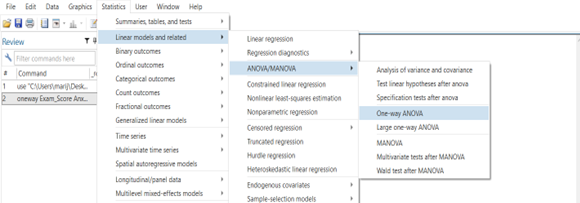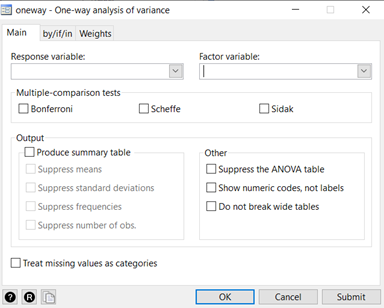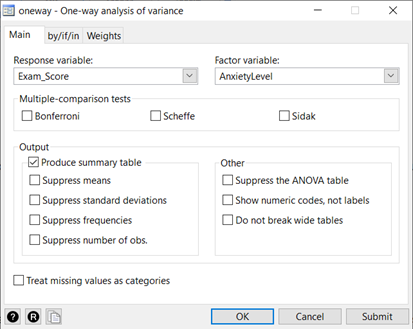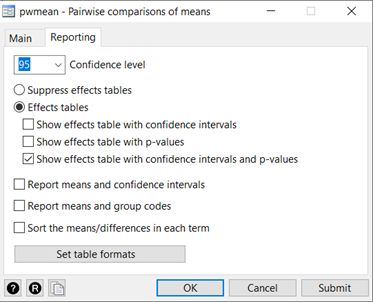One-Way ANOVA Test in STATA
Learn the One-Way ANOVA Test in STATA with our comprehensive guide. If you need an STATA expert for your data analysis, click below to Get a Free Quote Now!
Introduction
OnlineSPSS.com provides tailored statistical services for PhD students, researchers, and academics. We specialize in statistical data analysis and consulting, using advanced tools like STATA to help with dissertations, theses, capstone projects, and other research tasks.
- Services For: PhD Students, Researchers, Academics
- Academic Projects Supported: Dissertations, Theses, Capstone Projects, Academic Research, Assignments
- Services Provided: Data Management, Data Analysis, Writing Methodology, Writing Academic Results, Statistical Consulting
In this blog post, we will discuss how to perform a One-Way ANOVA in STATA, an essential statistical test for comparing the means of three or more independent groups. This guide is particularly useful for researchers analyzing data across different categories.
Understanding how to perform and interpret a One-Way ANOVA in STATA can significantly impact the accuracy of your research findings. By the end of this post, you will have a clear grasp of the steps involved and the importance of correctly interpreting the results. This knowledge will empower you to apply this statistical test confidently in your academic work.
Whether you need help with STATA, SPSS, or any other statistical software, OnlineSPSS.com connects you with experienced statisticians who can guide you through every step of your project. Get started by requesting a FREE Instant Quote now.
PS: Need One-Way ANOVA in SPSS or R? Check out our guides for SPSS and R here.
1. What is One-Way ANOVA and Its Assumptions?
One-Way ANOVA is a statistical test used to determine if there are statistically significant differences between the means of three or more independent groups. Unlike a t-test, which compares only two means, One-Way ANOVA extends the comparison to multiple groups, making it invaluable for comprehensive research. The test assumes that the groups are independent, the data within each group is normally distributed, and the variances across groups are equal.
Moreover, the test checks for homogeneity of variance, meaning the spread or variability of scores is similar across all groups. If these assumptions are met, One-Way ANOVA provides reliable results. Therefore, understanding and verifying these assumptions is crucial before performing the test in STATA.
2. How to Perform One-Way ANOVA in STATA?
Performing a One-Way ANOVA in STATA is straightforward. First, load your dataset by using the “use” command or the “import” feature if your data is in a different format. Next, check your data for the assumptions discussed earlier, especially normality and homogeneity of variance. You can use STATA commands like “summarize” for descriptive statistics and “graph” for visual checks.
Once you verify the assumptions, run the One-Way ANOVA using the command oneway dependent_variable independent_variable. STATA will then output the results, including the F-statistic and p-value. To further analyze group differences, you can use post-hoc tests like Tukey’s Honest Significant Difference, available through the command pwcompare.
3. Example for One-Way ANOVA Using STATA
Let’s consider an example where you want to compare exam scores across students with different anxiety levels (low, middle, and high). First, you would load your data into STATA and verify the assumptions for One-Way ANOVA. After confirming that your data meets the necessary criteria, you run the test using the command oneway exam_scores anxiety_level.
STATA will then output the results, showing whether there are significant differences in exam scores based on anxiety levels. If the p-value is less than 0.05, you conclude that at least one group’s mean score is significantly different from the others. Post-hoc tests can identify which specific groups differ from each other.
4. STATA Output for One-Way ANOVA Test
The output from STATA for a One-Way ANOVA test includes several key tables:
- ANOVA Table: Shows the sources of variance, including Between Groups, Within Groups, and Total, along with their corresponding sum of squares, degrees of freedom, mean squares, F-statistic, and p-value.
- Descriptive Statistics Table: Lists the mean, standard deviation, and number of observations for each group. This helps in understanding the basic distribution of your data.
- Post-Hoc Test Results: If you conduct post-hoc tests, this table will show the pairwise comparisons between groups, including confidence intervals and p-values for each comparison.
Each table provides critical information needed to interpret the results of the One-Way ANOVA test.
5. Interpret the Key Results for One-Way ANOVA
Interpreting the results of a One-Way ANOVA in STATA involves looking at the F-statistic and the p-value. If the p-value is below 0.05, it indicates a significant difference between group means. This means that the factor you are testing (e.g., anxiety levels) has a statistically significant effect on the dependent variable (e.g., exam scores).
Furthermore, you should review the post-hoc tests to identify which specific groups differ. If the post-hoc results show significant differences, this will inform you of the specific impact of the independent variable on your dependent variable. Understanding these key results enables you to draw accurate conclusions from your research data.
6. Final Thoughts and Further Support
At OnlineSPSS.com, we are dedicated to helping PhD students and researchers with their statistical analysis needs, especially when using STATA. Whether you’re working on a dissertation, thesis, or another academic project, we offer a wide range of services to support you.
Explore our specialized pages for more information:
- STATA Dissertation Help (Marketing Dissertation, Psychology Dissertation, Sociology Dissertation, Public Health Dissertation, Economics Dissertation)
- Pay Someone to Do My STATA Project
- STATA Help for Statistical Analysis
- Find a STATA Helper for Research
- Hire a STATA Expert for Academic Research
- STATA Expert Help
- Online STATA Help
Whether you are a beginner or need help with advanced features, this service enables you to apply the correct techniques to your specific marketing research questions, leading to robust results. For a tailored solution, get your free instant quote now.







